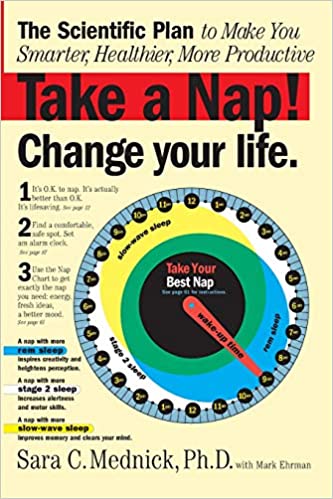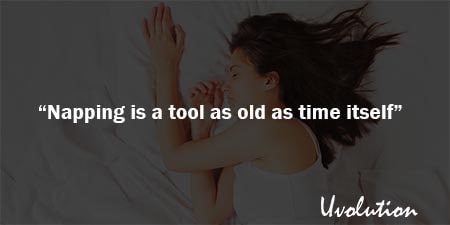Take a Nap Change Your Life by Dr Sara Mednick
The Book in 1 Sentences
“The ‘big picture’ message is that napping is a necessary and effective tool that can be used by anyone in pursuit of optimum health, happiness and productivity. I want to tell you why that is so, and how to make that knowledge work for you, your family, your company and your community. I want to make you a napper.” ~ Sara Mednick, Ph.D.
9 BIG Ideas
1. Napping is a Tool as Old as Time Itself
2. Sleeplessness & Fatigue Effects
Take a Nap! Change Your Life Book Summary
1. Napping is a Tool as Old as Time Itself
“Let’s look at the rest of the animal kingdom. Do any other species try to get all their sleep in one long stretch? No. They’re all multiphasic, meaning that they have many phases of sleep.
Homo sapiens (our modern industrialized variety, anyway) stand alone in attempting to satisfy the need for sleep in one phase. And even that distinction is a relatively recent development.
For most of our history, a rest during the day was considered as necessary a component of human existence as sleeping at night. As A. Roger Ekirch, one of the few historians to study sleep, put it, ‘Napping is a tool as old as time itself.’”
“By the first century B.C., the Romans had divided their day into periods designated for specific activities, such as prayer, meals and rest. Midday became known as sexta, as in the sixth hour (noon by their way of counting), a time when everyone would go to bed. The word has survived in the familiar term siesta.”
“Our results back up what historians, anthropologists, artists and numerous brilliant leaders and thinkers have been telling their contemporaries throughout the ages. In a perfect world, all humans, including you, would nap.”
“Recent breakthroughs in sleep research show that the simplest solution lies in restoring the nap, a resource as old as history itself.”
“Then one afternoon in my lab... I had my hellooo moment: Learning after a nap is equal to learning after a full night of sleep! Test scores of non-nappers deteriorated across the day!
That’s what my research proved.”
2. Sleeplessness & Fatigue Effects
“Before Thomas Edison’s lightbulb, our great-grandparents would get as much as 10 hours’ rest during an average weeknight. Today, we’re lucky to get eight hours on the weekend.
The amount of actual weeknight slumber has shrunk, on average, to an alarming 6.7 hours. We are a nation of the walking tired, so much so that 51 percent of the workforce reports that sleepiness on the job interferes with the volume of work they can do.
One in five adults is so sleepy that it interferes with his or her daily activities a few days a week, while an additional 20 percent report impairment a few days a month.
Once the nation with the most productive workforce in the world, the United States, by a number of measures, has fallen behind countries such as France and Germany. Our standard of living is slipping.
Our students are underperforming. Our collective health is deteriorating. In areas such as science and technology, we no longer dominate. Politicians, pundits and experts from all fields have made an industry out of explaining what’s going wrong. But continually overlooked is the role of that quiet little demon: fatigue.”
“The mental health picture is equally depressing. Studies have conclusively linked sleeplessness to irritability, anger, depression and mental exhaustion.”
3. Inadequate Sleep is VERY Dangerous
“After air, food and water, sleep is the most critical necessity for maintaining the body’s vital organs and systems...
Study after study has found that decreased levels of nocturnal sleep are associated with increased risk of breast cancer and colon cancer, as well as disregulation of hormones that control appetite.
It’s about time for our surgeon generals, who rightly warn us about the evils of cigarette smoking, to put a little effort into raising consciousness about the dangers of sleep loss.”
“Scientists no longer argue about whether napping is natural or unnatural, helpful or unhelpful. These are givens.”
4. 20 Reasons to Nap
“It’s free, nontoxic and it has no dangerous side effects. Hard to believe, with these powerful selling points, that people have to be convinced to nap. But alas, for way too long, napping has been given a bad rap... But as the facts pile up, the case for napping becomes too compelling to dismiss.
If you’re a closet napper, come out and show some pride . . . help your fellow employees, family members and friends to see the light. And for those of you who still insist on saying, ‘Give me one good reason why I should nap,’ science can do better than that. It can give you 20 reasons. Napping will allow you to:
1. Increase your alertness.
2. Speed up your motor performance.
3. Improve your accuracy.
4. Make better decisions.
5. Improve your perception.
6. Fatten your bottom line.
7. Preserve your youthful looks.
8. Improve your sex life.
9. Lose weight.
10. Reduce your risk of heart attack and stroke.
11. Reduce your risk of diabetes.
12. Improve your stamina.
13. Elevate your mood.
14. Boost your creativity.
15. Reduce stress.
16. Help your memory.
17. Reduce dependence on drugs/alcohol.
18. Alleviate migraines, ulcers and other problems with psychological components.
19. Improve the ease and quality of your nocturnal sleep.
20. It feels good.”
5. Does Napping Affect Sleep?
“I’m often asked if a nap during the day will interfere with nocturnal sleep. The answer is a definite no.
Unfortunately, many information sources on sleep hygiene encourage people to avoid napping if they’re having trouble sleeping at night.
Not only is there not a shred of evidence to support this advice, but much of the data coming out of sleep research demonstrates quite the opposite.
In studies across all age ranges, nocturnal sleep duration has been proven to be unaffected by midday napping. As a matter of fact, studies indicate that in a number of cases napping actually improves the ability to sleep at night.”
“The amount of nocturnal sleep you get is the most fundamental element in any sleep profile, since it has the greatest impact on all of your wellness indicators.”
6. Post-Workout Nap
“Everyone knows that exercising at least 20 minutes (ideally more) several days a week improves cardiovascular fitness. But regular exercise is also recommended to help you sleep well.
The timing of the workout, however, is important. Low body temperature is good for nocturnal sleep, so if you exercise late in the day and have trouble falling asleep, try moving your regimen earlier than four hours before bedtime to give your body a chance to cool down.
For napping, on the other hand, high body temperature is optimal, so a post-workout nap can be just what the doctor ordered and an easy solution for nappers in training.”
7. Who’s Got Time to Nap?
“‘Who’s got time to nap?’ is a common complaint among non-nappers. The short answer is: just about everyone.
If you spend 20 minutes or more at Starbucks getting an afternoon mocha latte, couldn’t you just stay where you are and take a nap instead?
So, before you conclude that napping doesn’t fit into your busy life, take out your day planner and examine your schedule. By carefully reviewing the activities of your day and the time it takes to do them, you can assess which time expenditures are unnecessary and where a nap can be substituted.
How long is your lunch? A paralegal with an hour lunch break reports that she can eat in half an hour and keep the second half for her nap. Or do what I do and pencil in 20 to 40 minutes as soon as you get home for a transition nap between work and leisure.
Once you’ve carved out those precious minutes, you need to make this nap time a regular feature of your day.
Just as we’ve developed a detailed trail of cues for our minds and bodies to recognize that it’s time for nighttime sleep, we need to fashion a similar set of cues that will indicate that it’s nap time.
Consistent scheduling allows the body to associate that hour with the nap and all other concerns to more easily fade away.”
“Napping during the day will elevate your mood and give you a lot more energy that you can share with your loved ones. You might even discover that napping with your partner can improve the relationship!”
8. Cognitive Napping Aversion
“Even with a diet free of stimulants and an environment where conditions are optimal, some people still might find that they’re unable to nap—largely because of the noise in their own heads.
If you have internalized negative beliefs or attitudes, it doesn’t matter how careful and meticulous your nap preparations have been—you might as well be trying to nap in the middle of a busy intersection.
It’s time to confront this beast head on by identifying the most common varieties of a syndrome we call cognitive nap aversion or CNA. This syndrome refers to the thoughts that prevent your body from following the normal pathway to sleep. The solution is a three pronged attack: Identify, Address, Replace.
1. Identify. Before you can make any headway as a napper, it’s important to recognize any negative attitudes or beliefs that stand in the way of your nap and how you came to have them.
2. Address. Once a particular mindset is exposed, you can ‘treat’ it with clinical and research-based information. Only then will you be able to understand that your misperceptions are neither factual nor helpful.
3. Replace. Having cast off your misperceptions, don’t just leave your mind in ‘neutral.’ Fill that old mental space with a more positive associative set.”
Here are some suggestions from Mednick:
“If I nap, I’m being lazy.”
Replace with: “Napping makes me more productive.”
“I’m too busy to nap.”
Replace with: “I’m so busy, I need to nap.”
“I can’t get anything out of a 20-minute nap, so why bother.”
Replace with: “In less than 20 minutes, I will restore my alertness for the rest of the day.”
9. Stick With It
“Again, don’t expect miracles. The most profound and durable changes in life take place slowly. Be patient with yourself. And stick with it...
From your first nap to your 10th nap to your 110th nap, this little resource will never stop delivering better health, a cheerier mood, more brain power and extra stamina.
Instead of constantly needing more to get the same level of benefit, as people tend to do with chemical helpers, you will actually start spending less time napping because you’ve learned how to fall asleep at will and your nap has become more efficient. As any veteran napper can attest, it only gets better over time.”
That was my QUICK summary of the great book Take a Nap Change Your Life by Dr Sara Mednick. If you’re interested, get your copy. There is a HUGE amount of life-changing ideas in this book, and we’ve only touched on a tiny bit of it.
Buy The Book: Take a Nap Change Your Life by Dr Sara Mednick

GET Blinkist 7 Days FREE Trial
3000+ Book Summaries
(Audio and Text)






